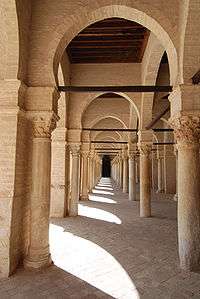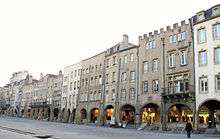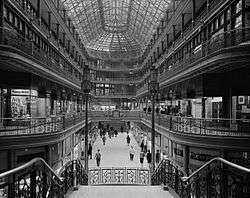Arcade (architecture)

An arcade is a succession of arches, each counter-thrusting the next, supported by columns, piers, or a covered walkway enclosed by a line of such arches on one or both sides. In warmer or wet climates, exterior arcades provide shelter for pedestrians. The walkway may be lined with stores.[1] A blind arcade superimposes arcading against a solid wall.[2] Blind arcades are a feature of Romanesque architecture that was taken into Gothic architecture.
Etymology
The word "arcade" comes from French arcade from Provençal arcada or Italian arcata, based on Latin arcus, ‘bow’ (see arc and arch).[3]
History

In Gothic architecture, the arcade can be located in the interior, in the lowest part of the wall of the nave, supporting the triforium and the clerestory in a cathedral,[4] or on the exterior, in which they are usually part of the walkways that surround the courtyard and cloisters.
European and North American shopping arcades resemble the bazaars and souks of Asia and North Africa.
One of the earliest examples of a European shopping arcade, the Covered Market, Oxford, England was officially opened on 1 November 1774 and is still active today. The Covered Market was started in response to a general wish to clear "untidy, messy and unsavoury stalls" from the main streets of central Oxford. John Gwynn, the architect of Magdalen Bridge, drew up the plans and designed the High Street front with its four entrances. In 1772, the newly formed Market committee, half of whose members came from the town and half from the university, accepted an estimate of nine hundred and sixteen pounds ten shillings, for the building of twenty butchers' shops. Twenty more soon followed, and after 1773 meat was allowed to be sold only inside the market. From this nucleus the market grew, with stalls for garden produce, pig meat, dairy products and fish.
Gostiny Dvor in St Petersburg, Russia is another early shopping arcade. Sprawling at the intersection of Nevsky Prospekt and Sadovaya Street for over one kilometer and embracing the area of 53,000 m2 (570,000 sq ft), the indoor complex of more than 100 shops took twenty-eight years to construct. Building commenced in 1757 to an elaborate design by Bartolomeo Rastrelli, but that subsequently was discarded in favour of a less expensive and more functional Neoclassical design submitted by Jean-Baptiste Vallin de la Mothe (1729–1800).
Throughout the following century, Gostiny Dvor was augmented, resulting in ten indoor streets and as many as 178 shops by the 20th century. During the post-World War II reconstructions, its inner walls were demolished and a huge shopping mall came into being. This massive 18th-century structure got a face-lift recently and entered the 21st century as one of the most fashionable shopping centres in Eastern Europe.[5]
An early French arcade is the Passage du Caire created in 1798 as a tribute to the French campaign in Egypt and Syria. It was appreciated by the public for its protection from the weather, noise and filth of the streets.[6] A year later American architect William Thayer created the Passage des Panoramas with a row of shops passing between two panorama paintings. Shopping arcades increasingly were built in the second Bourbon Restoration.[7] Upper levels of arcades often contained apartments[8] and sometimes brothels.[9]
Notable arcades


Shopping arcades
- Arcade Building , Asheville, North Carolina, United States
- Brisbane Arcade, Brisbane, Australia
- Burlington Arcade, London, England
- Cleveland Arcade, Cleveland, Ohio, United States
- The Corridor, Bath, England
- Covered Market, Oxford, England
- Dayton Arcade, Dayton, Ohio, United States
- Eaton Centre, Toronto, Ontario, Canada
- Galeries Royales Saint-Hubert in Brussels, Belgium
- Galleria Vittorio Emanuele II, Milan, Italy
- GUM, Moscow, Russia
- Çiçek Pasajı, Istanbul, Turkey
- Galleria Subalpina, Turin, Italy
- Galleria Umberto I, Naples, Italy
- Lanes and Arcades of Melbourne, Australia; Block Arcade; Royal Arcade
- Nashville Arcade, Nashville, Tennessee, United States
- Nickels Arcade, Ann Arbor, Michigan
- Old Bank Arcade, Wellington, New Zealand
- Paddock Arcade, Watertown, New York, United States
- The Passage des Panoramas, Paris, France
- The Passage de l'Argue, Lyon, France
- The Royal Arcade, London
- Rue de Rivoli, Paris, France
- Stanford University, Stanford, California, United States
- Silver Arcade Silver Arcade, Leicester, United Kingdom
- The Strand Arcade Sydney N.S.W., Australia
- Great Gostiny Dvor St. Petersburg, Russia
- The Passage St. Petersburg, Russia
- Victoria Quarter, Leeds, England
- Westminster Arcade, Providence, Rhode Island, United States
Religious buildings
- Great Mosque of Córdoba, Spain
- Mission San Fernando Rey de España - Architecture of the California missions, United States
- Mosque of Uqba, Kairouan, Tunisia
- Real Monasterio de Nuestra Senora de Rueda, Aragon Autonomous Community, Spain
See also
| Wikimedia Commons has media related to Arcades. |
- Alley
- Aqueduct
- Bazaar
- Lanes and arcades of Melbourne, Australia
- Market (place)
- Roman aqueduct
- Shophouse,
- Shopping mall
- Souq
- Stoa
- Tong lau
References
- ↑ New Oxford American Dictionary
- ↑ James Bettley and Nikolaus Pevsner (2007), Essex. The buildings of England, Yale University Press, page 865
- ↑ New Oxford American Dictionary
- ↑ William Chambers (1973), Chambers's encyclopaedia, Volume 1, International Learning Systems Corp, p. 534
- ↑ Bogdanov, I.A. , Bolshoi Gostiny dvor v Peterburge. SPb, 2001
- ↑ p. 174 Desmons, Gilles Walking Paris New Holland Publishers, 2008
- ↑ p. 386 Ayers, Andrew The Architecture of Paris: An Architectural Guide Edition Axel Menges, 2004
- ↑ p. 32 Benjamin, Walter & Tiedemann, Rolf The Arcades Project Harvard University Press, 1999
- ↑ p. 88 Rabaté, Jean-Michel Given: 10 Art 20 Crime : Modernity, Murder and Mass Culture Sussex Academic Press, 2007